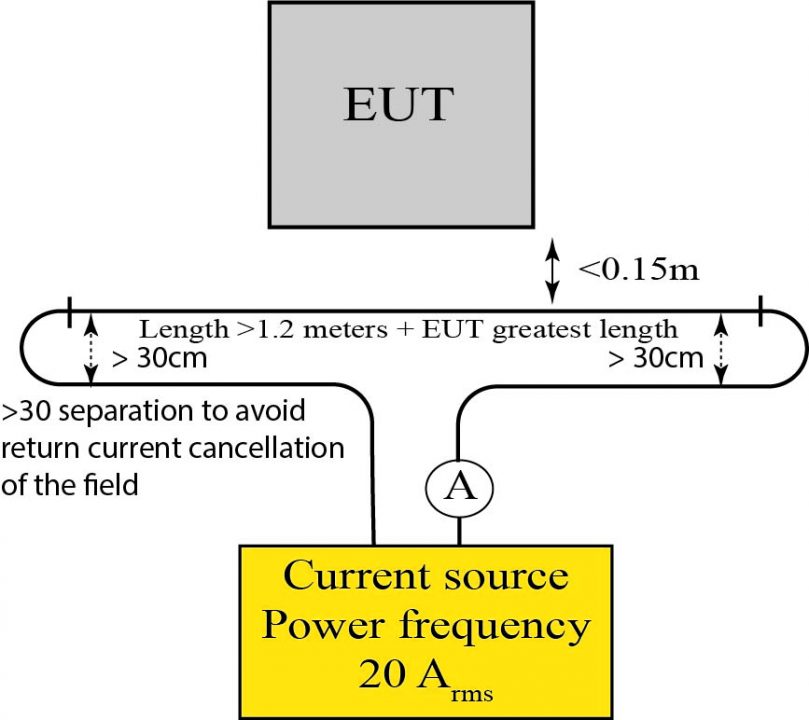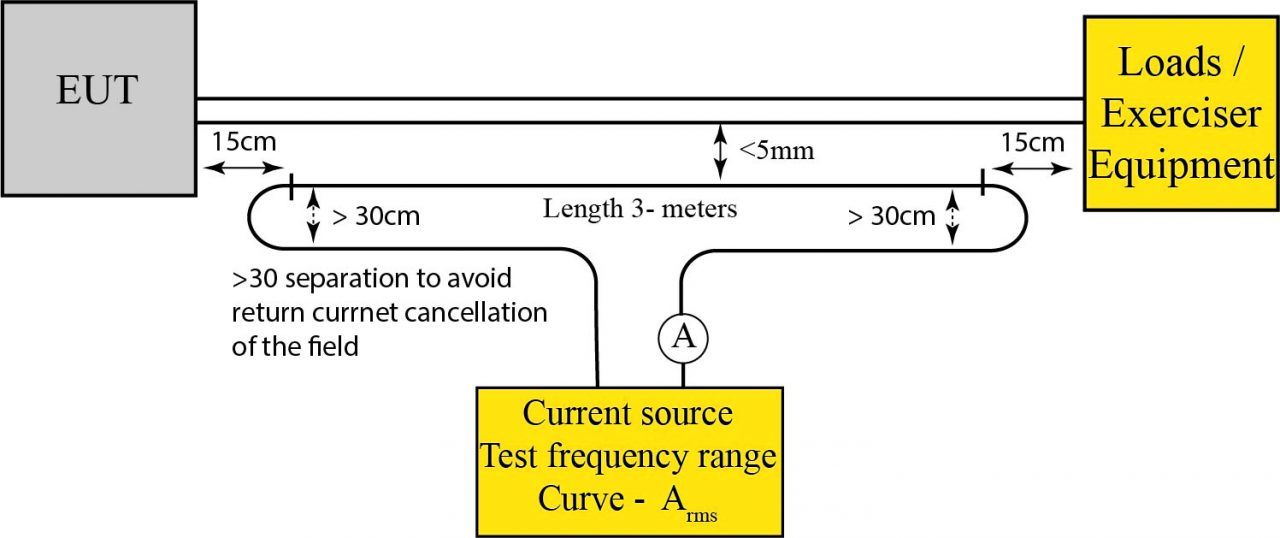The Issue
Induced signal susceptibility has been a factor in electronic equipment performance since the dawning of voltage and current. Often referred to as crosstalk, the undesired coupling of one circuit’s signals to another may result in interference that degrades the integrity of either signal.
This article examines the testing process prescribed by RTCA DO-160 Section 19 as part of the electromagnetic compatibility (EMC) requirements. These requirements evaluate the equipment under test (EUT) tolerance for capacitive and inductive coupling to the EUT or associated cables. The evaluation covers coupling over the power frequency (including harmonics) range, the audio frequency range, and electrical transients.
Equipment Categories
The requirements are established by a three-letter code to designate the performance requirements for the device and the type of power operation. Table 1 provides a definition of the category designations.
Table 1: Category Designation
| First Letter | Requirement |
| C | Interference-free operation is required; severe coupling potential is present |
| Z | Interference-free operation is required |
| A | Interference-free operation is desired |
| B | Interference is controlled to a tolerable level |
| Second Letter | Power type |
| C | Constant frequency power type (400 Hz or DC) |
| N | Narrow frequency range (350 Hz to 650 Hz) |
| W | Wide frequency range (350 Hz to 800 Hz) |
| Third Letter | E-field into equipment |
| E | Equipment qualified for E-field into equipment |
| X | Equipment NOT qualified for E-field into equipment |
Test Levels
Five different test methods are included in the standard with the applicability and test levels specified category. This information is provided in a table within Section 19 of the standard. The table points to some figures that include graphs of the test levels based on the test frequency range. We will be discussing some of these as we review each of the test methods.
The audio frequency cable test levels are based on a cable length of 3.3 meters, including 15 cm lengths at each end of the cable. Where the installation drawings specify a shorter cable, the test level may be adjusted downward by the ratio of the specified cable length to the 3-meter basis (the 15-cm lengths are dismissed for the coupling length). For example, if the actual cable length is 1 meter, then the test level would be 1/3 of the specified test level. This does not imply that short cables can be used in the test configuration unless the shorter length is specified by the installation drawings.
Remember that the cables used during the test represent the installation. Do not add shielding or twisting unless it is specified in the installation drawings.
Frequency Scanning/Dwell Time
The standard requires at least 30 frequencies per decade over the test frequency range where scanning is applicable to the test method. Equation 1 shows a formula for calculating the frequency increments.

Equation 1: Formula, Log Spaced, 30-Points/Decade
where:
| fn | Test frequency in Hz, n=1 to m |
| f1 | Start frequency |
| fm | End frequency |
| m | 1+30*log(fm/f1) |
The dwell time at each frequency is at least 10 seconds but not less than the time that it takes for the EUT to accomplish an operation cycle. If a continuous frequency sweep is used, then the sweep time per decade is 5-minutes (10-seconds * 30-points).
Equipment Induced Magnetic Fields
Figure 1 provides a general test configuration diagram for the equipment induced magnetic field testing. The current flowing through the wire creates a magnetic field and the field flux lines reach the EUT boundary and may penetrate into the circuitry. This penetration may interfere with the EUT operation. This test evaluates the ability of the equipment to tolerate this magnetic field exposure.
Since the electrical power distribution is typically the current source with sufficient magnitude to create large magnetic fields, the testing is accomplished at 400 Hz for the constant frequency power system and at the frequency extremes for the narrow and wide power frequency systems. The test current is normally set to 20 amperes but may be adjusted if the installation would result in exposure to greater currents. Do NOT synchronize the interference signal with the EUT power input.
The support structure to hold the coupling wire straight must be magnetically transparent to prevent concentration or redirection of the flux lines through a permeable material. Most test facilities use an adjustable power source to manage the current amplitude, but an adequately rated rheostat may be used if the power source is fixed.
The coupling wire is oriented horizontally and moved across the EUT face slowly to allow sufficient tie for the EUT to respond to interference. Repeat the coupling wire movement over each EUT face maintaining the separation distance. Although the standard does not require testing of the EUT bottom, consider adding this face to the test sequence if that face could be exposed to cables, especially power distribution cables.

Equipment Induced Electric Fields
Figure 2 provides a general test configuration diagram for the equipment induced electric field testing. The applicability of this test method is limited to devices without an external metallic chassis. I get questions indicating that some readers of the standard understand the exclusion also applies to devices with non-conductive covers. That interpretation of the statement is incorrect—just metallic coverage is exempt. This indicates that a metallic chassis with openings such as displays should be considered for test if the installation could place a voltage source adjacent to the display.
The procedure places an open circuit charged line within 1 cm of the device face where the parasitic capacitance allows the charge to be applied to the EUT surface, charging the non-conductive material. If the charge is not tolerated by the device, the performance may be degraded.
Much like the magnetic field test above, the charged line is swept over the EUT face slow enough to allow an EUT response if it is susceptible.
Note that the resistor in the charged line prevents a hazardous current to the test engineer just in case of discharge through the contact with the coupling wire. This also would limit current flow to the EUT if arcing should be supported through the device. The test configuration drawing show an insulation thickness of the charged line to be at least 7 mm to avoid direct contact of the wire to the chassis—capacitive coupling only.
The test voltage is normally 170 volts at 400 Hz for all categories. The test frequency is NOT synchronized with the EUT power frequency. Consider adding the bottom face to the test if it could be exposed to a charged line adjacent to that face.

Interconnecting Cable Induced Magnetic Fields
Figure 3 provides a general test configuration diagram for the cable induced magnetic field testing. The current flowing through the wire creates a magnetic field and the field flux lines engulf the adjacent cable inducing a current into the wiring. This coupling may interfere with the EUT operation. This test evaluates the ability of the equipment to tolerate this magnetic field exposure.
The diagram shows a nice straight wire tightly coupled to the cable under test, but in reality, the cable and coupling wire are routed with some bends with the coupling cable taped to the cable being tested for the specified length. Note that short cables would see a limit adjustment as described above.
Since the electrical power distribution is typically the current source with sufficient magnitude to create large magnetic fields, the test level is highest in the power frequency range and diminishes with increased frequencies over the audio frequency range. The test level curves are provided in the standard with the measurement units of A-m where A is the amperage and the m represents cable length in meters. A test level of 30 A-m indicates a current of 10 amperes and cable exposure over 3 meters. The current source is NOT to be synchronized with the power to the EUT. The test level is stated in RMS units.
The test frequency range is swept using the scan rate and dwell times stated above while monitoring the EUT for indications of susceptibility. The test is repeated for each interconnecting cable. Note that the cables are to be terminated at each end with appropriate loads or simulation equipment.

Interconnecting Cable Induced Electric Fields
Figure 4 provides a general test configuration diagram for the cable induced electric field testing. The voltage applied to the open circuit coupling wire will capacitively couple to the cable under test and may produce a voltage on the wires interfering with intentional cable signals. This test evaluates the ability of the equipment to tolerate this electric field exposure.
The diagram shows the coupling wire wrapped around the cable under test for the specified wire length. Recall that short cables are allowed a limit adjustment as described above. Keep the coupling wire tight against the cable under test. Taping the wire to the cable after wrapping will help maintain the tight coupling.
Since the electrical power distribution is typically the primary voltage source with sufficient magnitude to create large electric fields, the test level is highest in the power frequency range and diminishes with increased frequencies over the audio frequency range. The test level curves are provided in the standard with the measurement units of V-m where V is the voltage and the m represents cable length in meters. A test level of 5,400 V-m indicates a voltage of 1,800 volts and cable exposure over 3 meters. The voltage source is NOT to be synchronized with the power to the EUT. The test level is in RMS units.
The 1,800 volts specified places the test level into the medium voltage range, so the high-level ratings need to be considered for the test equipment. For example, the typical power source could be rated for 300-volts and a step-up transformer would be used to attain the 1,800 volts. The medium voltage transformer is not a usual laboratory item so the inset low voltage transformer arrangement shown in Figure 4 could be used with each transformer stepping up to 600 volts and the series arrangement produces the 1,800 volts. This would keep each transformer within the low voltage range. Also, make sure that the coupling wire insulation is adequate for the 1,800 volts to prevent arc through. The voltage used for this test may require support by a licensed electrician depending on local regulations—be especially careful with this test configuration.
Unless there is a fault condition the current is limited, but make sure to include the current limiting resistor in case of current because of a fault or via distributed parasitic capacitance of the wiring.
The test frequency range is swept using the scan rate and dwell times stated above, while monitoring the EUT for indications of susceptibility. The test is repeated for each interconnecting cable. Note that the cables are to be terminated at each end with appropriate loads or simulation equipment.

Interconnecting Cable Induced Spikes
Figure 5 provides a general test configuration diagram for the cable induced spike testing. The unsuppressed relay is used to produce transients from inductive kick associated with the relay coil. When the timer operated the switch, current flow is interrupted and the relay coil magnetic field collapses creating a high voltage because of the high open-circuit impedance. Once the voltage increases to a level high enough to arc across the timer contacts a transient occurs. The transient repeats until the relay coil energy is dissipated producing several high voltage spikes. The voltage and spike duration may vary, and some spikes will not reach the 600-volt test level. The dissipation time varies from approximately 50 to 1,000 microseconds with a pulse repetition period of 2 to 10 microseconds. This test evaluates the ability of the equipment to tolerate these transients coupled into the interconnecting cables. The relay coil parameters are documented in the standard.
The diagram shows the coupling wire wrapped around the cable under test for the specified wire length. The test level is NOT adjusted for short cables. Keep the coupling wire tight against the cable under test. Taping the wire to the cable after wrapping will help maintain the tight coupling. Since the cable wrapping is like the electric field induction test, it is convenient to do that test and this test while the cable is wrapped with the coupling wire.
The time is set to produce a transient burst eight to ten times per second. The test is applied for at least 2-minutes while monitoring the EUT for indications of susceptibility. The power supply polarity to the relay coil is reversed and the test repeated with negative spikes. The test is repeated for each interconnecting cable. Note that the cables are to be terminated at each end with appropriate loads or simulation equipment.

Summary
Hopefully, you will find this information useful and I welcome questions. I have an Excel spreadsheet that can be used as a data collection sheet. It calculates many of the test parameters once you have selected the category and cable length. For the frequency sweep tests, you can overwrite the suggested frequency increment to find the test level the amplitude to be applied. It also graphs your applied levels as you input data. I will share the spreadsheet at no charge if requested—just email a request stating that you will not distribute or place in the public domain, and I will send it.
If you have a topic associated with EMC that you would like to have reviewed, let me know and I will try to place it in the queue for future articles.




